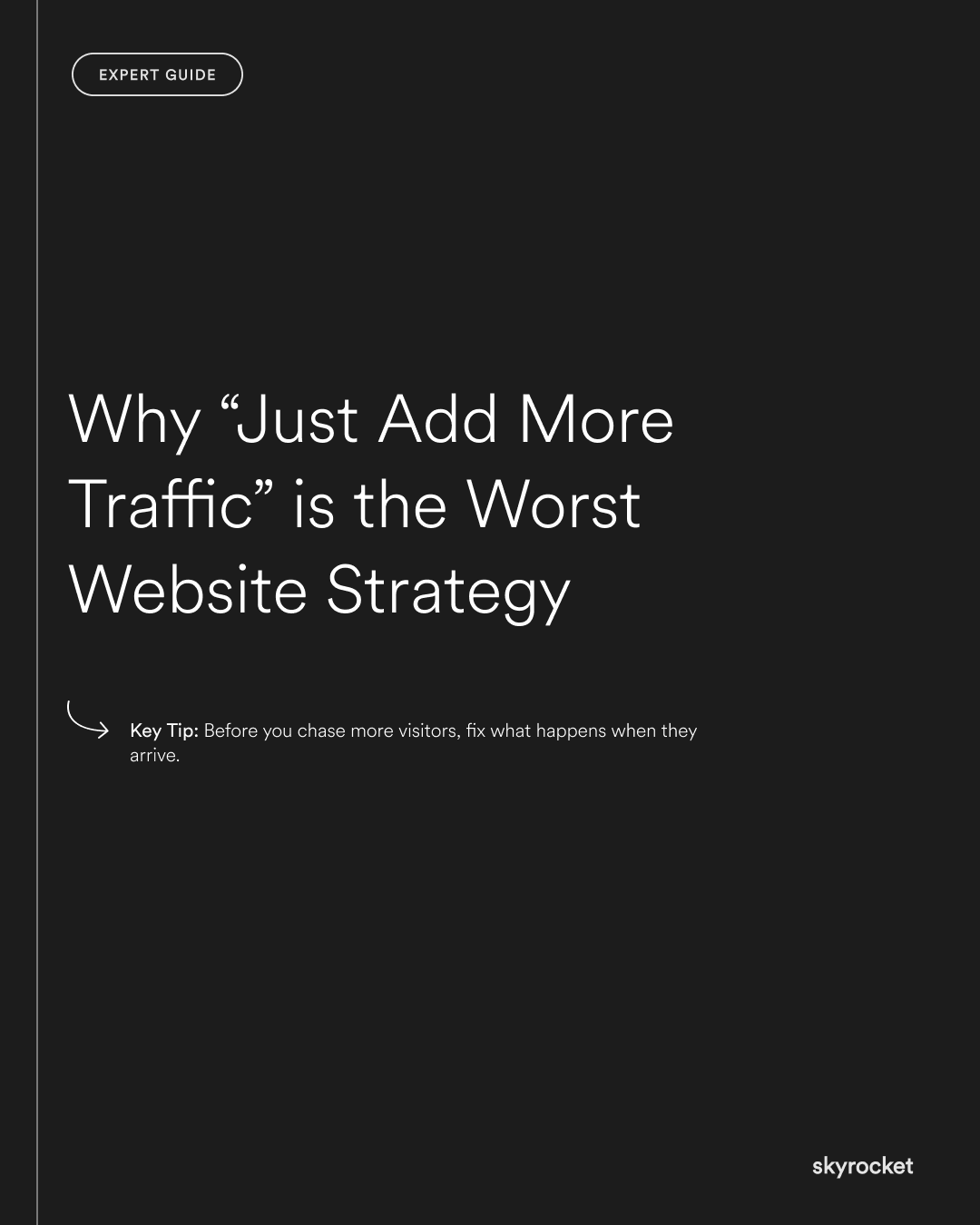When a website underperforms, the first reaction is almost always the same: “We just need more traffic.”
It sounds sensible. More visitors should mean more sales, right?
Not quite.
Pouring more people into a broken funnel only wastes money. It hides deeper issues and gives the illusion of progress while nothing actually improves.
If your marketing spend keeps growing but your sales don’t, the problem probably isn’t reach. It’s what happens once people arrive.
Why this matters for your business
Your website is one of the biggest marketing investments your company makes. If it fails to convert visitors into customers, every other marketing channel underperforms.
Traffic without conversion is just noise. The real value of a website lies in its ability to turn attention into action.
When conversion rates drop, three things happen:
- You lose revenue. More people visit, but fewer buy.
- Your acquisition costs rise. You spend more for each lead or sale.
- Team confidence drops. It becomes harder to justify further investment.
This is the hidden opportunity cost of a poor-performing site.
Key Tip: Before you chase more visitors, fix what happens when they arrive.
Improving conversion rates before increasing traffic can double your ROI without increasing your ad spend. Think of it like repairing a leaky pipe. If half your water is spilling out, turning up the tap only makes a bigger mess.
Fix the leaks first. Then add pressure.
Section 1: Why “more traffic” feels like the answer
Traffic is easy to measure and looks impressive on reports. When charts go up, it feels like success.
But vanity metrics can be misleading. Doubling your visitors doesn’t help if your conversion rate halves at the same time. You can have more traffic and make less money.
Example:
A Wellington retailer increased ad spend by 50 percent to boost visits. Monthly sessions jumped from 20,000 to 30,000, but conversion fell from 2.4 percent to 1.6 percent.
Despite a surge in visitors, sales actually declined.
The problem wasn’t visibility. It was performance.
Section 2: What drives real website growth
The businesses that outperform their competitors focus less on volume and more on efficiency. They care about how effectively their site converts attention into measurable results.
Three numbers tell the real story:
Conversion rate
This shows what percentage of visitors take meaningful action, such as buying, enquiring or subscribing. Even a small lift makes a big impact. A rise from 2 to 3 percent means 50 percent more results without extra traffic.
Cost per acquisition
This measures how much you spend to win each new customer. When your site converts better, this number drops, giving you more margin to reinvest.
Customer lifetime value
Good websites don’t just convert once. They build trust that drives repeat business. Each satisfied customer becomes cheaper to retain and more valuable over time.
Section 3: The three biggest conversion leaks
If your marketing feels inefficient, these are usually the culprits.
1. Unclear messaging
If visitors can’t tell who you are, what you do, or why they should care within seconds, they leave. Most sites talk too much about themselves and not enough about the customer’s problem.
Fix it:
Lead with outcomes, not features. Replace “We offer innovative digital solutions” with “We help NZ businesses grow faster through smarter websites.”
2. Confusing navigation
When visitors have to think too hard to find what they need, they give up. Every unnecessary click increases the chance they’ll exit.
Fix it:
Simplify the journey from first click to enquiry or purchase. Each page should make the next step obvious and effortless.
3. Friction in performance
Slow load times, broken forms, or clunky mobile layouts all create invisible barriers. You rarely hear about them from customers, but they quietly reduce trust and conversions.
Fix it:
Audit performance regularly. Use analytics and heatmaps to see where users drop off. Address small issues before they become expensive ones.
Section 4: Why conversion beats traffic every time
Imagine two businesses. One attracts 10,000 visitors and converts two percent. The other attracts 7,000 visitors and converts three and a half percent.
The second business ends up with more leads, more sales, and far higher ROI — even with less traffic.
Conversion efficiency compounds over time. Each small improvement multiplies the value of every future visitor.
Section 5: How to start fixing conversion problems
Conversion improvement is not guesswork. It is a repeatable process built on data and testing.
Step 1: Diagnose before you invest
Check analytics before spending on ads. Identify pages with high traffic but low engagement or completion rates. These are where you’ll get the fastest wins.
Step 2: Simplify your message
If your core value proposition takes more than a few seconds to grasp, rewrite it.
Customers buy outcomes, not complexity.
Example:
Instead of “We deliver tailored accounting solutions,” say “We help NZ businesses save time and reduce tax risk with proactive accounting.”
Step 3: Build trust
Prospects buy when they feel confident. Add testimonials, client logos, certifications or results close to decision points. These reassure people that others have chosen you before.
Step 4: Speed up and smooth out
A one-second delay in load time can reduce conversions by up to seven percent. Prioritise mobile experience — it’s how most of your audience interacts.
Step 5: Test and learn continuously
Small improvements stack up. Test call-to-action wording, layouts or imagery. A single change might only increase conversions by one percent, but across a year that can mean thousands in extra revenue.
Section 6: Key Tip: Get more value from the visitors you already have
You don’t need double the visitors to double your sales. You just need to make the most of the traffic you already get.
Optimising conversion turns your website into an asset that compounds over time. Every improvement boosts every channel — paid ads, SEO, email and referrals.
When your site converts well, your marketing spend finally works the way it should.
Section 7: Common misconceptions
“We’ll just spend more on ads.”
Extra spend only magnifies inefficiency. If your website converts poorly, you’ll just pay more for the same result.
“Traffic growth proves we’re doing well.”
High traffic means nothing if revenue isn’t rising. Look beyond vanity metrics.
“We’ll optimise later.”
Later is always too late. Optimising early saves thousands once campaigns scale. Every inefficiency becomes more expensive the longer you ignore it.
Section 8: The compounding power of small wins
Conversion improvements rarely feel dramatic in the short term, but they add up fast. A 10 percent lift per quarter compounds to more than 45 percent over a year.
Example:
A Christchurch services firm improved page layout, clarified messaging and streamlined forms. Conversions rose steadily each quarter. Within 12 months, leads doubled without increasing ad spend.
That’s the power of continuous optimisation.
Section 9: When increasing traffic finally makes sense
Once your website converts efficiently, more traffic becomes valuable. You’ll know exactly how much revenue each new visitor produces, and scaling will multiply growth rather than waste budget.
Traffic growth works when:
- The site experience is fast and clear.
- Conversion data is accurate.
- You know your cost per lead or sale and it’s profitable.
Adding traffic before fixing performance is like advertising a store before you fix the doors.
Section 10: Align your team around performance
Strong conversion performance doesn’t come from marketing alone. It happens when every team understands their role.
- Sales provide feedback on lead quality.
- Marketing tests copy, visuals and landing pages.
- Leadership sets measurable goals linked to revenue.
Example:
A national distributor introduced monthly “website performance meetings.” Marketing reviewed analytics, sales shared insights, and leadership decided priorities. Within six months, their site became the highest-converting channel in the business.
Alignment turns data into action.
Section 11: Key Tip: It’s cheaper to optimise than to attract
Every dollar you spend improving conversion stays in your business. Every dollar spent on traffic disappears the moment campaigns stop.
Traffic is rented. Conversion is owned.
That’s why the most profitable companies invest in optimisation first.
Section 12: What to do now
If you’re tempted to boost traffic, stop and measure first.
- Audit your funnel. Identify where visitors drop off or hesitate.
- Clarify your message. Make your value proposition clear and customer-focused.
- Fix usability. Speed, simplicity and mobile experience drive trust.
- Test before scaling. Improve performance, then grow reach.
- Track outcomes. Measure ROI monthly and adjust fast.
Once your site performs, every marketing dollar compounds instead of leaks away.
What It All Means
More traffic will not fix a weak website. It only makes inefficiencies more expensive.
The fastest way to grow isn’t shouting louder. It’s converting better.
Optimise before you amplify, and your website will become a genuine growth engine for your business.
If you’d like expert help improving conversion before increasing traffic, Skyrocket partners with NZ businesses to build and optimise Webflow and Shopify websites that deliver measurable ROI.



